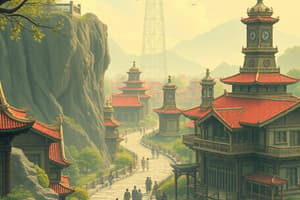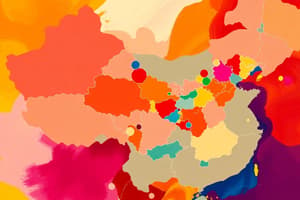Podcast
Questions and Answers
What was the main goal of the one-child policy implemented in China?
What was the main goal of the one-child policy implemented in China?
The main goal was to control population growth and limit families to one child to alleviate economic and social issues.
How did the one-child policy affect women's roles in Chinese society?
How did the one-child policy affect women's roles in Chinese society?
The one-child policy allowed women to gain more education and opportunities, transforming their roles in society.
What were some negative effects of the one-child policy regarding gender ratio?
What were some negative effects of the one-child policy regarding gender ratio?
The policy created a gender imbalance, leading to a disparity in the ratio of males to females at birth.
What exemptions were made to the one-child policy over the years?
What exemptions were made to the one-child policy over the years?
What implications did the one-child policy have on reproductive rights?
What implications did the one-child policy have on reproductive rights?
What is the predicted percentage of China's population that will be over 60 years old by 2050?
What is the predicted percentage of China's population that will be over 60 years old by 2050?
What family structure is commonly referred to as '4-2-1'?
What family structure is commonly referred to as '4-2-1'?
What is a significant disadvantage of living in 'Shikumen' housing?
What is a significant disadvantage of living in 'Shikumen' housing?
In what year was Pudong designated as a new development zone?
In what year was Pudong designated as a new development zone?
What type of farming is predominantly practiced in Sichuan Province?
What type of farming is predominantly practiced in Sichuan Province?
What major economic transformation took place in Shenzhen in the 1980s?
What major economic transformation took place in Shenzhen in the 1980s?
What are some tax benefits for businesses operating in Shenzhen's Special Economic Zone (SEZ)?
What are some tax benefits for businesses operating in Shenzhen's Special Economic Zone (SEZ)?
Name one major high-tech company headquartered in Shenzhen.
Name one major high-tech company headquartered in Shenzhen.
What is a prominent problem associated with Shenzhen's rapid economic growth?
What is a prominent problem associated with Shenzhen's rapid economic growth?
Why do many rural individuals migrate to Shenzhen?
Why do many rural individuals migrate to Shenzhen?
What is a key concern regarding labor conditions in Shenzhen?
What is a key concern regarding labor conditions in Shenzhen?
What type of housing units were common in Sichuan Province before modernization?
What type of housing units were common in Sichuan Province before modernization?
How has the population increase in Shanghai affected rural areas?
How has the population increase in Shanghai affected rural areas?
What type of buildings characterized Shikumen housing?
What type of buildings characterized Shikumen housing?
Flashcards
One-Child Policy
One-Child Policy
A policy implemented in China in 1979, limiting families to one child, aimed at controlling population growth and improving living standards.
Exceptions to One-Child Policy
Exceptions to One-Child Policy
A policy change in 1984 allowing some families to have a second child, particularly those in rural areas or with specific circumstances (e.g., both parents only children, first child disabled).
Benefits of the One-Child Policy
Benefits of the One-Child Policy
The positive outcomes of the One-Child Policy, including improved living standards, increased women's education and employment opportunities, and decreased poverty.
Disadvantages of the One-Child Policy
Disadvantages of the One-Child Policy
Signup and view all the flashcards
End of One-Child Policy
End of One-Child Policy
Signup and view all the flashcards
Ageing Population
Ageing Population
Signup and view all the flashcards
China's Population Concerns
China's Population Concerns
Signup and view all the flashcards
Shikumen Housing
Shikumen Housing
Signup and view all the flashcards
Pudong
Pudong
Signup and view all the flashcards
Subsistence Farming
Subsistence Farming
Signup and view all the flashcards
Shenzhen
Shenzhen
Signup and view all the flashcards
Shenzhen's SEZ Policies
Shenzhen's SEZ Policies
Signup and view all the flashcards
Unsustainable Development
Unsustainable Development
Signup and view all the flashcards
Labor Exploitation
Labor Exploitation
Signup and view all the flashcards
Reliance on Exports
Reliance on Exports
Signup and view all the flashcards
4-2-1 Family Structure
4-2-1 Family Structure
Signup and view all the flashcards
Rural-Urban Migration
Rural-Urban Migration
Signup and view all the flashcards
Extended Family
Extended Family
Signup and view all the flashcards
Central Courtyard House
Central Courtyard House
Signup and view all the flashcards
Study Notes
China's Population Policies
- 1975: China implemented a "late, long, and few" slogan, promoting late marriage and fewer children.
- 1979: The Communist Party mandated a one-child policy, officially limiting families to one child.
- 1984: China adjusted the policy, allowing some exceptions for rural areas and certain circumstances (disabled child, ethnic minorities, remote areas, and both parents being only children).
- 2013: An exception was added, allowing two children for families where only one parent was an only child.
- 2015: The one-child policy was abolished, allowing all couples to have two children.
Benefits of the One-Child Policy
- Empowerment of women: Increased educational opportunities for women.
- Financial benefits for families: The ability to provide better education and opportunities for the single child.
- Increased job opportunities: More jobs became available in China due to the workforce having one less child per family to provide for.
- Improved health outcomes: Increased life expectancy and reduced poverty.
Disadvantages of the One-Child Policy
- Forced contraception and sterilization: Mandatory use of contraception and sterilization measures.
- Gender imbalance: Created a disproportionate gender ratio at birth in China, favouring males over females in many ways.
- Child abandonment and adoption: Forced parents to abandon or give up children for adoption.
- Unnecessary fertility counseling: Couples seeking fertility counseling even when not necessary.
- Migration for childbirth: Chinese citizens would leave the country to have children.
- Violation of UN reproductive rights: Violated United Nations policies on reproductive rights.
- Ageing population: Growing elderly population, threatening the overall workforce strength.
China's Population Concerns
- Ageing population: Life expectancy increased from 40 in 1950 to 73 in 2010. Predictions indicate more than 30% of the population will be over 60 by 2050. This is a 4-2-1 family structure (four grandparents, two parents, and one child).
"Shikumen" Housing
- Former prevalence: Housing more than 60% of Shanghai's population in the 1950s.
- Decreasing prevalence: Rapidly disappearing.
- Characteristics: Closely packed, 2-3 story buildings. Often in disrepair due to age.
- Amenities: Some converted to community amenities due to densely populated areas.
- Living conditions:
- Advantages: Convenience, low amenity costs. Close-knit social ties provided increased security.
- Disadvantages: Fire hazards, lack of running water and sufficient space for growing population. Overcrowding.
Pudong
- Transformation: Pudong waterfront transformed into a major development zone since 1990, resulting in today's iconic skyline.
- Economic hub: Significant presence as important port, sporting venue, financial center, high tech zones.
Sichuan Province
- Rural life: Primarily farmers, living at subsistence levels in single-room farmhouses around courtyards.
- Modernisation: Recent improvements in housing with running water, electricity, and multiple bedrooms; however, lacks sewage disposal.
- Traditional farming: Rice cultivation and fish/duck farming continue.
- Economic challenges: Low wages and manual labour used in traditional agriculture techniques.
- Potential benefits of rural growth: Cost of living being lower with less pollution and access to fresh air. Food needs of the growing population of Shanghai.
- Concerns: Challenges with modern machinery and industrialization
Shenzhen
- Rapid growth: From a fishing town of 30,000 to a world city and manufacturing hub with 12 million people in recent decades.
- Economic activities: Electronics, telecommunications, high technology, financial services, and tourism are significant to the economy.
- Location: Situated in Guangdong province, part of the Pearl River Delta region. Close proximity to Hong Kong and Macau via transportation.
- Status: Special Economic Zone (SEZ) since 1979.
- Development policies: Tax exemptions, grants/loans, and reduced rates for businesses within the SEZ. Foreigner friendliness.
- Economic impact: Attributed significant growth to China's economy, but leading to various concerns.
- Concerns: Unsustainable use of resources, pollution, exploitation of labour due to low wages and long work hours. Compromises for industrial safety and health. Dependence on export demand, making it susceptible to international economic changes.
Studying That Suits You
Use AI to generate personalized quizzes and flashcards to suit your learning preferences.




